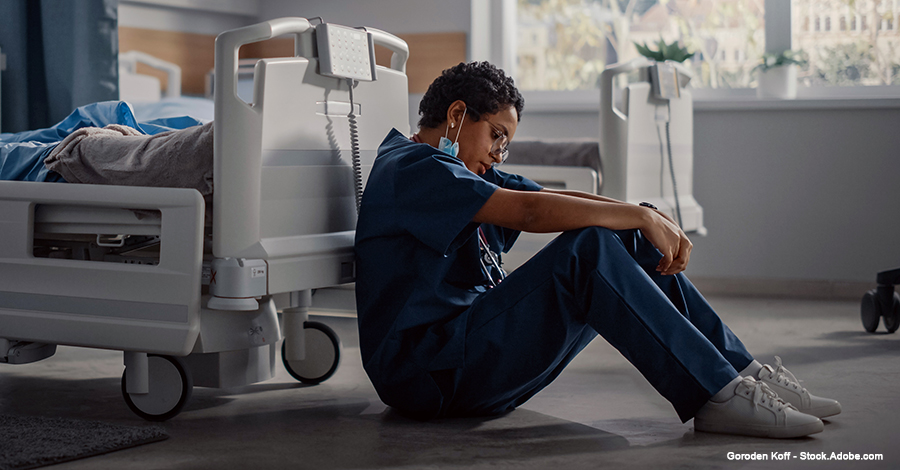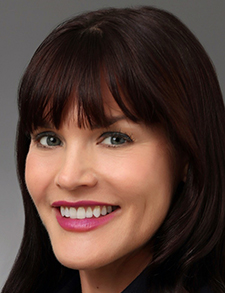 Hospitalist and palliative-care physician Kencee Graves, MD, FACP, recalls participating on a difficult code-team response while still a new medicine intern at the University of Utah, where she is now chief medical officer for inpatient health. This case was her first death on duty.
Hospitalist and palliative-care physician Kencee Graves, MD, FACP, recalls participating on a difficult code-team response while still a new medicine intern at the University of Utah, where she is now chief medical officer for inpatient health. This case was her first death on duty.

Dr. Graves
The patient was a woman in her 40s brought in by ambulance after an unexpected cardiac arrest in the community. “It was awful because her family was out in the hall waiting and watching. It was just this overall very traumatic experience,” Dr. Graves said. “We were ultimately unsuccessful in resuscitating her on a second attempt, despite a lot of effort. And for those of us who were in a learning position, residents, and interns, we were all a little shell-shocked.”
She continued, explaining that the next morning the attending came into the hospital and said, “‘For today’s didactic session, we’re going to talk about what happened last night.’ It still amazes me how cathartic that experience was, having that talk. I remember thinking that taking the time to honor that person and discuss what happened helped us all move forward.”
One name for this kind of postmortem conversation by the hospital team is debriefing, although it’s also called a time-out or a pause. It is increasingly done in hospitals when a patient dies, typically after an unsuccessful code.1 Different hospitals and teams may approach debriefings in different ways, with greater or lesser degrees of formality and structure, sometimes but not always with an emphasis on medical trainees.2 Debriefings have been shown to improve participants’ ability to manage their grief and are associated with lower rates of burnout.
The American Heart Association’s Advanced Cardiac Life Support protocol spells out how to do a debriefing as a facilitator-led, reflective, participant discussion of the events, assimilated into the trainees’ learning.3 In 2009 Jonathan Bartels, a trauma- and emergency-care nurse, developed the medical pause, a procedure implemented after the death of a patient.4 Any member of the medical team can request a pause after an unsuccessful code, preferably performed immediately after the death is called around the patient’s bedside.
Doing a debriefing in the room of a patient who has just died may not always be advisable, however, depending on the presence and emotional state of the family. Busy schedules and competing pages and texts also need to be overcome. It may mean taking the team down the hall to the nearest available conference room and asking everyone to hold their pages for the few minutes of the debriefing. But regardless of those constraints, the debriefing should be done as soon as it can be arranged for as many members of the team as possible. Whatever the format or setting, it shows the team that this moment is important because this death was significant.
When there is an event like this in the hospital, a code or rapid response or bad outcome, clinicians need an opportunity to acknowledge the loss, Dr. Graves said. “I think the worst thing we can do is act like nothing happened.”
Not just codes
“The baseline for debriefings was the code team,” she said. “But as I had more experience in my career, I started to realize there are a lot of events in the hospital beyond codes that can have as big an impact emotionally as a code does on residents, students, nurses, and other team members. So, I started debriefing every single big event—a code, a rapid response, a medical error, even a patient on comfort care whose death was anticipated. Sometimes those are wrought with complexity,” Dr. Graves said.
“I always start by asking the participants, ‘How are you doing? I want to be clear that I care about you as a human being. I want to help you get through this event, and that’s the point of why we’re doing this. Let’s take a second to recognize what happened, and talk about the questions you have, what you would have liked to see happen differently.’”

Dr. Razzak
Being able to express feelings is important, but for many participants, it’s also important to review the clinical facts of the case, bringing a quality-improvement perspective to the debriefing, said Rab Razzak, MD, a hospitalist and director of palliative care at University Hospitals in Cleveland. Like Dr. Graves, he is active in SHM’s Palliative Medicine Special Interest Group, which has tried to educate the hospital medicine field about debriefings. What went well? What could have been done differently? Are there ethical or moral issues to explore? What can we all learn going forward?
Moving on doesn’t work

Dr. Gundersen
Elizabeth Gundersen, (@top_gundersen), MD, FAAHPM, FHM, a hospitalist and palliative-care physician at the University of Colorado School of Medicine in Aurora, Colo., has a large role in medical education, working with students and residents. “I try to view this topic of debriefing after death from their perspective. Whether it is an expected or unexpected death, it can be traumatic, and the debriefing can help soften the blow,” she said.
“We learn in medical training that we need to put the needs of the patient first. So, if we’re rounding and something happens and a patient dies, we’ve trained ourselves to just pick up and soldier on and go see the next patient. I’ve had students come to me and say, ‘You know, the patient died, and the team just carried on like nothing happened,’” Dr. Gundersen said.
“Quite often the health care infrastructure/system has taught us that we need to keep seeing more patients,” Dr. Razzak said. “We have to hit our targets, our RVUs. And the culture historically has told us: You move on. One thing we’ve recognized, especially through the pandemic, is that we’re in a very different place today in medicine. Many of us are suffering from burnout, moral injury, and other emotions of despair or hopelessness.”
Doctors have learned that moving on doesn’t work. “There can be an emotional stacking effect that occurs from moving on, from not addressing what we’re going through, from not talking about it or processing it. It’s going to show up later, perhaps as no longer feeling engaged with our patients and families, which is a sign of burnout,” he said.
Palliative care’s contribution
Dr. Graves, who is also board-certified in hospice and palliative medicine, thinks hospital-based palliative-care teams have something to offer to the rest of the hospital when it comes to debriefings after sudden deaths. Palliative care may have more experience with in-the-moment debriefings for deaths on service since it often is involved with more of these challenging cases.
“Because we see difficult cases and deaths, we are aware that the risk of compassion fatigue and burnout are higher if we don’t,” she said. And the team’s commitment to interdisciplinary teamwork and person-centered care makes the debriefing even more important.
Palliative-care teams like hers dedicate time, perhaps weekly, to continue these conversations. “For my team, that’s where we formally pause, reflect, talk about our patients who have died, their lives, our journeys with them. Our chaplain does a kind of ritual, perhaps reading a poem, and we say their names. It’s a nice way to close the book of their lives.”
Based on its experience with creating opportunities for this kind of closure, the palliative-care team can be called on by hospitalists to help them enact debriefings for their patients, Dr. Graves said. “I think what palliative care can do well is help support other hospital teams through some of their toughest cases.”
Dr. Razzak’s team also meets weekly at a set time for a routine review of cases and to talk about how everyone is doing, what’s been hard, and what’s been enjoyable. “It actually helps us process, it helps us build community and move forward.”
Dr. Gundersen said that it’s important for hospitalists to have a method by which they debrief and process after patients’ deaths. “That is a skill of self-care that we need for ourselves, as well as teaching it to our learners. And if hospitalists are not doing it for themselves, then that’s the lesson they’re passing on to their learners,” she said.
“I’m making a case for why hospitalists need to role-model this, and why medical educators and the whole system need to be intentional about providing the spaces where we can talk about these cases.”
Larry Beresford is an Oakland, Calif.-based freelance medical journalist, specialist in hospice and palliative care, and long-time contributor to The Hospitalist.
References
- Kam AJ, et al. Implementation and facilitation of post-resuscitation debriefing: a comparative crossover study of two post-resuscitation debriefing frameworks. BMC Emerg Med. 2022;22(1):152.
- Govindan M, et al. Empowering residents to process distressing events: A debriefing workshop. MedEdPORTAL. 2019;15:10809.
- 2020 American Heart Association Guidelines for CPR and ECC: Part 7: Systems of care. American Heart Association website. https://cpr.heart.org/en/resuscitation-science/cpr-and-ecc-guidelines/systems-of-care. Published October, 2020. Accessed December 31, 2023.
- Bartels J. About the medical pause. Thepause.me website. https://thepause.me/2015/10/01/about-the-medical-pause/. Published October 1, 2015. Accessed December 31, 2023.


This article is helpful in giving some structure on debriefing in hospital setting especially modeling for our trainees to help then self care and decrease burn-out. Definitely sharing with our hospitalists for debriefing improvement. Thank you!